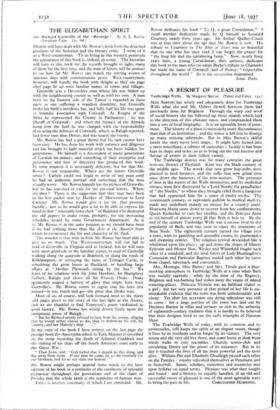A RESORT OF PLEASURE
Tunbridge Wells. By Margaret Barton. (Faber and Faber. 15s.)
Miss BARTON has wisely and adequately done for Tunbridge' Wells what she and Mr. Osbert Sitwell between them had
previously 'done for Brighton. Through the warp and woof of social history she has followed up those strands which lead in the direction of this pleasant town, and compounded them into a sort of local biography. It is an agreeable form of treat- ment. The history of a place is necessarily more discontinuous than that of an institution : and the writer is left free to diverge up many enticing sidetracks. But in Miss Barton's skilful. hands the story never loses shape. It might have turned into a mere miscellany, a cabinet of curiosities ; luckily it has been. kept in shape and order, so as to bring out the real interest and flavour of events in their fullest variety.
The Tunbridge district was for many centuries the great iron-ore district of England. Kent was the black country of the middle ages. The woods that now grow hop-poles were planted to feed furnaces, and the mills that now grind corn once drove the hammers of the iron-masters. The presence of iron in the waters of the Wells themselves, and its medicinal virtues, were first discovered by a Lord North, the grandfather of " the Norths," to whom they brought relief from a hangover that had oppressed him for a space of twelve weeks. The seventeenth century, so supremely gullible in medical mattas, made any -undefined malady an excuse for a country jannt.- Henrietta Maria came down to recover from her confinements,' Queen Katherine to cure her sterility, and the Princess Antie to rid herself of almost every ill that flesh is heir to. By the end of the century Tunbridge Wells was' a serious rival to the' popularity of Bath, and was soon to share the attentions of Beau Nash. The eighteenth century turned the village into
a town, with its gambling and assembly rooms, its promenades and shopping centres. The religious revival descended like a-
whirlwind-upon the place ; up -and down the slopes of Mount- Ephraim and Mount Sion, Wesley and Whitefield fought each' other to a standstill, and the rival forces of Lady Huntingdon's' Connexion and Particular BaptiSts ousted each other by turns' from chapel, tabernacle and conventicle.
Mrs. Montagu, Miss Burney and Mrs. Thrale gave a blue- stocking atmosphere to Tunbridge Wells at a time- when Bath. was socially suprenie : while by the time of the Regency, Brighton and sea-bathing had stolen away the vogue of inland watering-places. Princess Victoria was an habitual visitor as a girl ; but her very presence at that period of her life is un- mistakable evidence that the town was both unfashionable and cheap. Yet after her accession one dying splendour was still to come : for a large portion of the town was laid out by Decimus Burton in villas and terraces so rich in the urbanity of eighteenth-century tradition that -it is hardly to. be believed• that their designer lived to see the early triumphs of Norman. Shaw.
The Tunbridge Wells of today, with its common and its promenades, still keeps the spirit of an elegant resort, though it lives by its residents and no longer by its visitors. The very young and the very old live there, and come home at dusk from windy walks to cosy tea-tables. Church, tennis-club and circulating library are the pivots of its existence. But in its day it touched the- lives of all the most powerful and the most alive William Pitt and Elizabeth Chudleigh passed each other on the Pantiles : royalty refreshed themselves at Penshurst and at Somerhill. Saints, scholars, statesmen and eccentrics met upon holiday on equal terms. Pleasure was what they sought and found : and a history, so capably handled, of an- old and successful resort of pleasure is one of the most agreeable ways














































 Previous page
Previous page